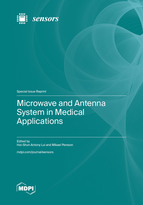Microwave and Antenna System in Medical Applications
A special issue of Sensors (ISSN 1424-8220). This special issue belongs to the section "Biomedical Sensors".
Deadline for manuscript submissions: closed (31 March 2023) | Viewed by 31329
Special Issue Editors
Interests: antenna arrays; smart antenna; direction-of-arrival estimation; mutual coupling; ultra wideband; radar sensing and imaging; radar signal processing; radar target recongition; radar cross section; terahertz radar; transient electromagnetics; biomedical electromagnetics; medical imaging; microwave tomography; computerized tomography; algebraic reconstruction techniques; engineering education; effective learning
Special Issues, Collections and Topics in MDPI journals
Interests: biomedical electromagnetics; medical diagnosis; stoke detection; microwave tomography; biomedical engineering
Special Issues, Collections and Topics in MDPI journals
Special Issue Information
Dear Colleagues,
This Special Issue of Sensors aims at reporting the latest research findings on microwave and antenna technologies in medical applications.
The non-ionizing nature of microwave radiation and low-cost microwave electronics offers innovative solutions for medical diagnosis, treatment, and health monitoring. Researchers in antennas, microwave electronics, computational electromagnetics, imaging, and signal processing are working collaboratively with medical practitioners, aiming at enhancing our living through developing next-generation healthcare technologies. A well-known example would be the potential use of microwave radiation for breast screening, which provides a non-ionizing, compression-free alternative to X-ray mammography and tomosynthesis for cancer diagnosis. Women of all ages over the world will benefit from this. Another example would be the prospect of utilizing microwave sensors for stroke detection such that prehospital diagnosis can be facilitated in ambulances through a portable system. In regional areas in Australia and Sweden, stroke patients and the elderly who are located remotely from hospitals will benefit from this. Clinical trials of microwave breast screening and stroke detection are currently in place across Europe, North America, and Oceania.
The recent boom in artificial intelligence (AI) and machine learning (ML) offers new avenues which accelerate technical development, particularly in signal processing and imaging. Although the recent focus is mostly on AI and ML, reliable medical solutions cannot be established without having a high-quality microwave and antenna system capturing the RF signals.
The scope of this Special Issue includes, but is not limited to, microwave and antenna systems that can be applied in medical diagnosis, health monitoring, ablation, and hyperthermia. Contributions toward system development and methodologies, including algorithms and imaging techniques, with medical-oriented applications in mind are welcome.
Dr. Hoi-Shun Antony Lui
Prof. Dr. Mikael Persson
Guest Editors
Manuscript Submission Information
Manuscripts should be submitted online at www.mdpi.com by registering and logging in to this website. Once you are registered, click here to go to the submission form. Manuscripts can be submitted until the deadline. All submissions that pass pre-check are peer-reviewed. Accepted papers will be published continuously in the journal (as soon as accepted) and will be listed together on the special issue website. Research articles, review articles as well as short communications are invited. For planned papers, a title and short abstract (about 100 words) can be sent to the Editorial Office for announcement on this website.
Submitted manuscripts should not have been published previously, nor be under consideration for publication elsewhere (except conference proceedings papers). All manuscripts are thoroughly refereed through a single-blind peer-review process. A guide for authors and other relevant information for submission of manuscripts is available on the Instructions for Authors page. Sensors is an international peer-reviewed open access semimonthly journal published by MDPI.
Please visit the Instructions for Authors page before submitting a manuscript. The Article Processing Charge (APC) for publication in this open access journal is 2600 CHF (Swiss Francs). Submitted papers should be well formatted and use good English. Authors may use MDPI's English editing service prior to publication or during author revisions.
Keywords
- medical diagnosis
- health monitoring
- hyperthermia
- ablation
- microwave imaging
- microwave sensing
- wearable and implantable devices
- antenna systems
- microwave systems
- medical applications







